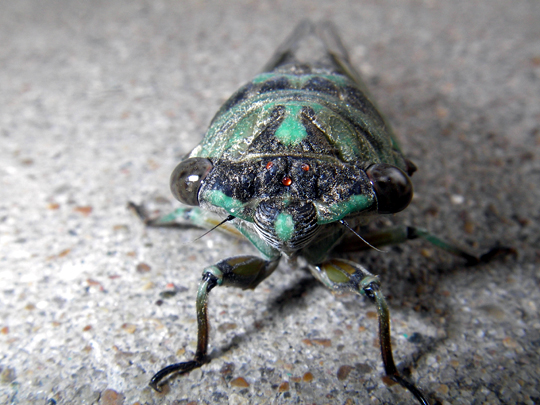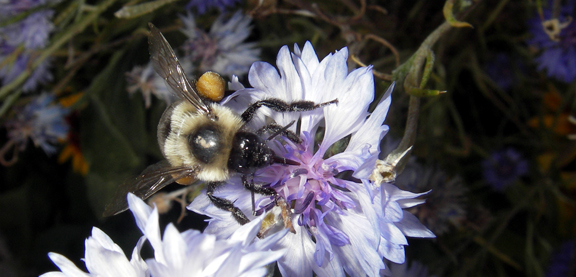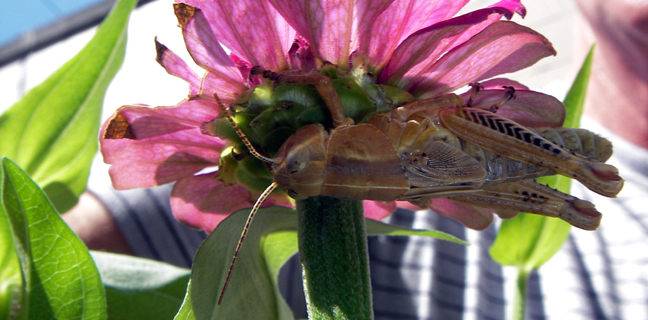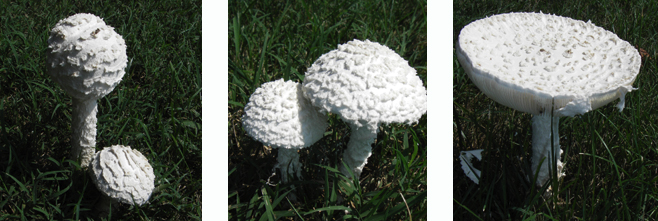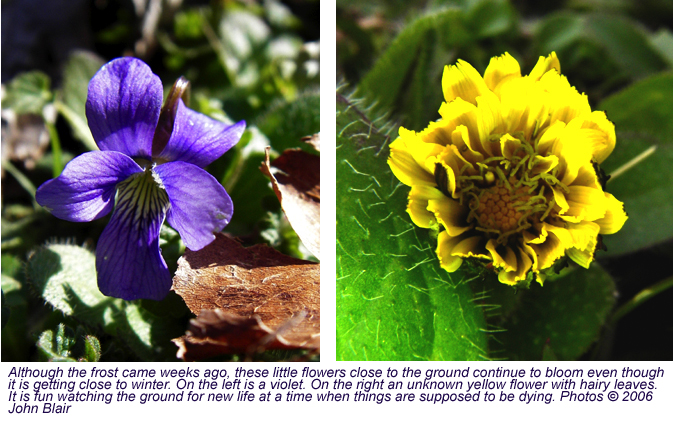More Views from the Valley Watch Garden
This brilliant red cosmos is hard to beat on a warm June day. Photo © 2006, John Blair
This interesting creature was found on some concrete near the garden. An up close look shows interesting details. We don’t know what this bug is and ask readers to offer us their opinions. And also, what the heck are those three beady things in the middle if its head? Photo © 2006 John Blair
This grasshopper has been growing in the garden. It has just recently sprouted wings. Although the garden has mostly flowers and a few vegetables, it seems that the most picturesque parts of the garden are it’s insects. Photo © 2006 John Blair
July 20. 2006 – This bee had a spiked snout. But what I noticed most was the near perfect sphere shaped pollen ball it carried on its hind legs. Photo © 2006 John Blair
This yellow bug was having a good time blending in with the beautiful yellow cannas that adorn the front of our building. Photo ©2006 John Blair
Photo ©2006 John Blair. We probably saw this grasshopper a week and a half ago on this page but it was smaller and its wings had just begun to grow. This time it was hanging upside down on a zinnia, a flower that is popular with myriad insects in the garden. Go to the Archives for even More Views from the Valley Watch Garden.
Too pretty to eat-poisonous shroom is beautiful work of nature
Photos © 2006 John Blair. These mushrooms shone like the sun against the deep green of a lawn on Evansville’s eastside early this week. Below is the description.
This beautiful but poisonous mushroom regularly amazes people by sprouting up in their lawns, often in large fairy rings, in summer and fall. It is easily identified if you have mature specimens in hand, since it has a distinctive greenish spore print and, in old age, greenish gills. If you do not have a mature specimen available, however, you may be hard pressed to reach a confident identification; young specimens in the “button” stage are nearly inseparable from the very similar Chlorophyllum rhacodes.
No mushroom causes more cases of mushroom poisoning in North America than Chlorophyllum molybdites (Beug, 2004). It is large, attractive, and readily available, since it frequents lawns across the continent. I know very experienced mushroom hunters who have poisoned themselves, mistaking it for closely related edible mushrooms like Chlorophyllum rhacodes and Macrolepiota procera.
The toxins in Chlorophyllum molybdites are usually not fatal, but I am told that the poisoning experience is quite unpleasant. A spore print, obviously, is a necessity if you are planning on eating any mushrooms in this species group!
In many areas east of the Rocky Mountains, Chlorophyllum molybdites is easily confused with the deadly poisonous Amanita thiersii, which also makes fairy rings and grows in troops in lawns. Close inspection, however, reveals that Amanita thiersii has a shaggy stem to go with its shaggy cap, as well as gills that are white at maturity. © mushroomexpert.com
Find out more about Mushrooms
 July 27, 2006 – Photo© 2006 John Blair. This butterfly took on the appearance of a vicious predator on close inspection. Here it drank nectar from a zinnia. CORRECTION-Previously, I had indicated that the zinnia was Indiana’s State Flower. That was incorrect. The State Flower is the Peony.
July 27, 2006 – Photo© 2006 John Blair. This butterfly took on the appearance of a vicious predator on close inspection. Here it drank nectar from a zinnia. CORRECTION-Previously, I had indicated that the zinnia was Indiana’s State Flower. That was incorrect. The State Flower is the Peony.
Insect life in the flower garden outside the Valley Watch office in Evansville have been teeming all summer. Literally hundreds of species have visited or inhabit the garden.
“Taking these close ups of flowers and the ecosystem they support has opened a new world of wonder for me,” said, John Blair.
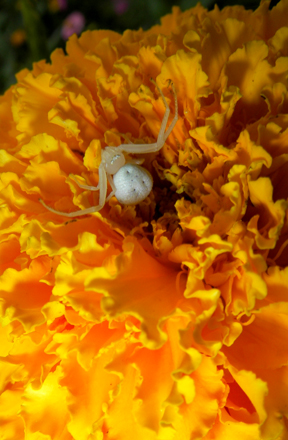 August 4, 2006 Photo © 2006 John Blair. This tiny white spider was feasting on a flower. August is the time when spiders seem to appear, including the common black and yellow garden spider. Additional pictures from the garden are available in the Archives located in the Library at left.
August 4, 2006 Photo © 2006 John Blair. This tiny white spider was feasting on a flower. August is the time when spiders seem to appear, including the common black and yellow garden spider. Additional pictures from the garden are available in the Archives located in the Library at left.
Time to be free
 August 8, 2006 – Photo ©2006 – John Blair, shows a cicada struggling to free itself of the shell that it has been in for months leading up to its release to freedom. The whole process took only minutes and the cicada seemed to expand in size rapidly once it was free. See more insects and other interesting things from the Valley Watch Garden and elsewhere under various months in the News Archives at left.
August 8, 2006 – Photo ©2006 – John Blair, shows a cicada struggling to free itself of the shell that it has been in for months leading up to its release to freedom. The whole process took only minutes and the cicada seemed to expand in size rapidly once it was free. See more insects and other interesting things from the Valley Watch Garden and elsewhere under various months in the News Archives at left.
More Views from the Valley Watch Garden
We may have seen this fellow before. A rather fat cicada, looking like an armored tank with wings, it has been hanging out in the garden much of the summer. Photo © 2006 John Blair. For more pictures from the garden click on the link below.
Moonflowers appeal to more than humans
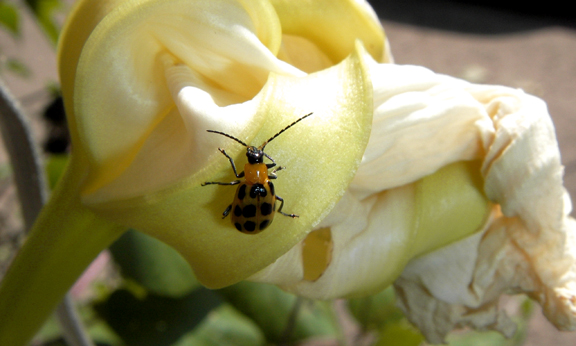 September 16, 2006 Photo © 2006 John Blair. This ladybug found delicate solace as it examined a shriveling bloom of a moonflower that bloomed last night. Last week’s torrential rain has help all the garden remain colorful and fragrant.
September 16, 2006 Photo © 2006 John Blair. This ladybug found delicate solace as it examined a shriveling bloom of a moonflower that bloomed last night. Last week’s torrential rain has help all the garden remain colorful and fragrant.
Go to Garden Photo Album
More Views from the Valley Watch Garden
 August 31. 2006 – Photo © 2006 John Blair. Surely, Monarch butterflies top the list as the most favored. Even their name implies something superior. Add to that the remarkable journey they make simply to get here and back from Mexico and they become almost legendary. Like most of the other insect in the garden, they seem to be drawn to all the zinnias but particularly the magenta zinnias.
August 31. 2006 – Photo © 2006 John Blair. Surely, Monarch butterflies top the list as the most favored. Even their name implies something superior. Add to that the remarkable journey they make simply to get here and back from Mexico and they become almost legendary. Like most of the other insect in the garden, they seem to be drawn to all the zinnias but particularly the magenta zinnias.
November 5, 2006 – Photos © 2006 John Blair. These bugs have appeared in the last few days on the leaves of clematis plants. These pictures seem to show the bug at various stages in its development but the funny thing is the bugs do not seem to move.
If anyone can identify these bugs, please send a reply to ecoserve1@aol.com
More Views from the Valley Watch Garden
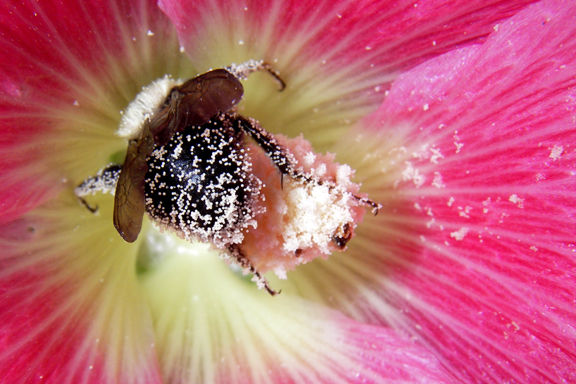 September 7, 2006 – Photo © 2006 John Blair. This bee just could not get enough of the pollen offered by this blooming Hollyhock. Honey bees have returned to the garden this week when the Clematis bloomed in its spicy aromatic fragrance. This bee took timeout from the Clematis to savor the Hollyhock. Hollyhocks usually bloom in June but this one is a second generation.
September 7, 2006 – Photo © 2006 John Blair. This bee just could not get enough of the pollen offered by this blooming Hollyhock. Honey bees have returned to the garden this week when the Clematis bloomed in its spicy aromatic fragrance. This bee took timeout from the Clematis to savor the Hollyhock. Hollyhocks usually bloom in June but this one is a second generation.
Still colorful in October
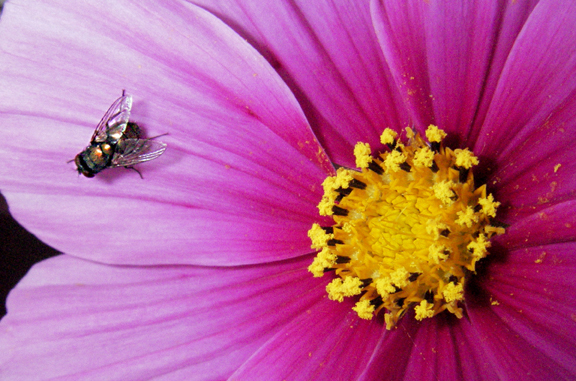 October 6, 2006 – Photo © 2006 John Blair. Cosmos in the garden have bloomed since June. White, pink, lavender, red and deep magenta blooms have attracted all sorts of creatures.
October 6, 2006 – Photo © 2006 John Blair. Cosmos in the garden have bloomed since June. White, pink, lavender, red and deep magenta blooms have attracted all sorts of creatures.
Lots of flies have come to the garden and they are camera shy. But the cool weather has really slowed them down, making them easier to photograph.
More Moonflowers
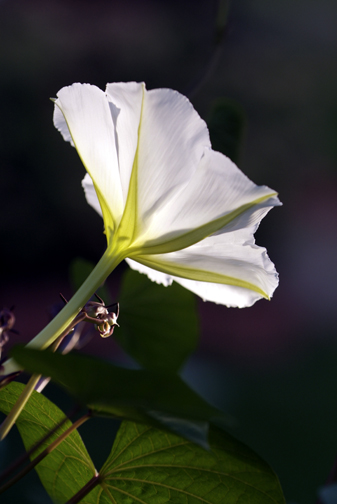 September 23, 2006 – Photo © 2006 John Blair . Moonflowers in the Valley Watch Garden survived the torrential rains we have experienced the last two days along the Ohio Valley. This picture shows the delicate bloom from the back.
September 23, 2006 – Photo © 2006 John Blair . Moonflowers in the Valley Watch Garden survived the torrential rains we have experienced the last two days along the Ohio Valley. This picture shows the delicate bloom from the back.
More Moonflowers
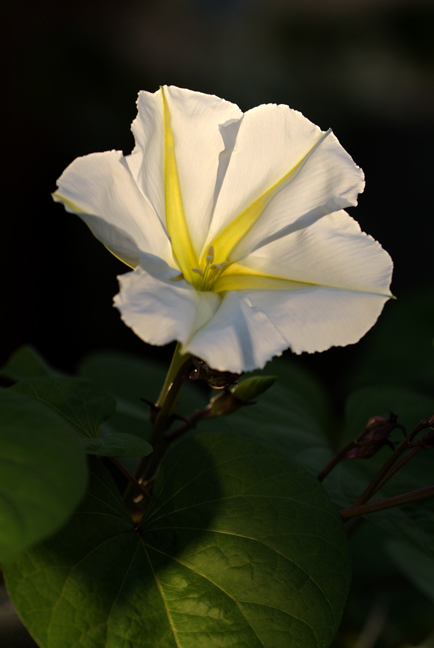 Photo © 2006 John Blair. I cannot stop shooting these beautiful flowers. Up close, they present the wonder of nature in geometric forms that need few if any words. For more photos from the Valley Watch Garden, click the link below.
Photo © 2006 John Blair. I cannot stop shooting these beautiful flowers. Up close, they present the wonder of nature in geometric forms that need few if any words. For more photos from the Valley Watch Garden, click the link below.
Go to Garden Photo Album
Moonflowers to brighten your day
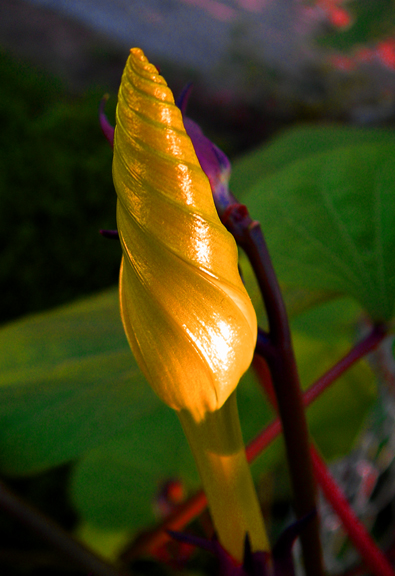 September 13, 2006 – Photo © 2006 John Blair. Moonflowers are delicate works of nature. While they produce large blooms that emerge in the late afternoon and bloom all night only to shrivel and die before the next day is over, they begin as a natural work of art, especially in the warm glow of a late afternoon sun.
September 13, 2006 – Photo © 2006 John Blair. Moonflowers are delicate works of nature. While they produce large blooms that emerge in the late afternoon and bloom all night only to shrivel and die before the next day is over, they begin as a natural work of art, especially in the warm glow of a late afternoon sun.
Go to Garden Photo Album
Moonflowers are making me Luny
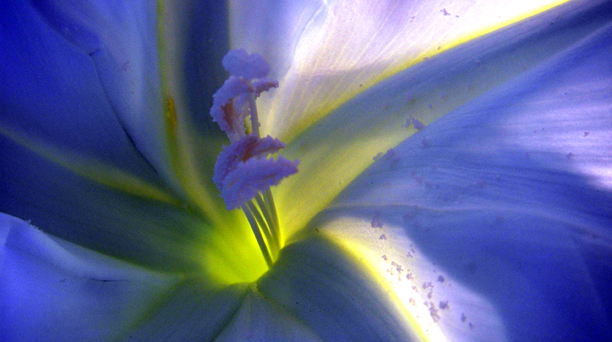 September 11, 2006 – Photo © 2006 John Blair. OK, here is the deal-I am a lunatic. I love watching the moon and celebrate its waxing and waning during each of its cycles. It follows, then that I should be mesmerized by Moonflowers.
September 11, 2006 – Photo © 2006 John Blair. OK, here is the deal-I am a lunatic. I love watching the moon and celebrate its waxing and waning during each of its cycles. It follows, then that I should be mesmerized by Moonflowers.
This is the first in a series of pictures of the moonflowers that are beginning to bloom in the Valley Watch Garden. They are fascinating flowers since they have such large blooms that only seem to last for a single night and then fall off. I call this one, Blue Moon since the colors are so vividly blue, due to the way it reacts to the light I used to illuminate it. More pictures of the Valley Watch Garden are available by clicking the link below.
Go to Garden Photo Album
Charlotte’s Web or Food for Life
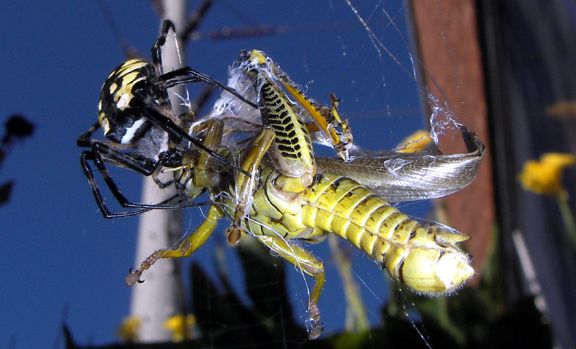 September 19, 2006 – Photo © 2006 John Blair. I have shot these creatures off and on all summer. But today this Grasshopper met an untimely death in the clutches of this Garden Spider. For the spider, it may be the last meal he needs before going into hibernation for the winter.
September 19, 2006 – Photo © 2006 John Blair. I have shot these creatures off and on all summer. But today this Grasshopper met an untimely death in the clutches of this Garden Spider. For the spider, it may be the last meal he needs before going into hibernation for the winter.
Garden spiders are orb weavers, known for their intricate orb-shaped webs. Web building is a complex process: support lines are constructed first; then the radial lines; and finally the spiraling strands are spun from the center outward. Without training from adults, even the tiniest just-hatched spiderlings are able to spin silk and weave webs. Another orb weaver, nephila, builds an extremely thick and strong web, up to eight feet in diameter. People in Southeast Asia have found an interesting use for this spider’s web — they bend a pliable stick into a loop and pass it through the large web, resulting in a surprisingly strong and effective fishing net!
Spiders produce silk from glands called spinnerets. Orb weavers can have three or four pairs of these glands, each producing different textures of silk: non-stick silk for the radial web lines, and sticky silk for the spiraling strands. Some spiders even produce an ultraviolet silk to attract insects. Spider silk, a super protein that hardens as it is stretched from the spinnerets, may look delicate but it is unbelievably tough. The relative tension necessary to break it is far greater than for steel.
When finished with the construction of its web, the garden spider will often go to the center, hang upside down, and wait for a flying or jumping insect to become ensnared. Having poor eyesight, orb weavers rely on a highly-developed sense of touch. When an insect becomes caught in the web and struggles, the spider is alerted by the vibrations. It rushes out to secure its prey, usually wrapping it in silk. A poison is injected into the victim, paralyzing it and converting the contents of its body to liquid. The spider returns later to insert its tube-like fangs and suck up its meal.
The garden spider’s profound sense of touch has another purpose: it provides male spiders with a channel to communicate with females. Before climbing onto the female’s web, the male taps out a special message. Then he cautiously crawls toward his mate — a perilous task, for he is always in danger of being mistaken for prey. It is commonly thought that the female spider kills and eats the male after mating, but this is an exaggeration. The male, who stops eating during his mate-hunting ordeal, generally dies of malnourishment and exhaustion.
Spiders are similar to, but not the same as insects. They belong to the class Arachnida, named after Arachne, a maiden in Greek mythology. She defeated the goddess Athena in a weaving contest. In a fury of anger, Athena destroyed Arachne’s weaving and beat the girl about the head. In utter disgrace, Arachne hanged herself. A regretful Athena changed Arachne into a spider so that she could weave forever.
While they are certainly not going to win any popularity contests, spiders’ insect-eating habits are extremely helpful to humans. Every year, billions of spiders do away with a large number of disease-carrying and crop-destroying insects. If every spider ate just one a day for a year, those insects, piled in one spot, would weigh as much as 50 million people. Spiders are, by far, the most important predator of insects in our world.
Source: http://www.abirdshome.com/gardenspiders.html
Morning Glories are in the same biological family as Moonflowers
 Photo © 2006 John Blair. Morning Glories are in the same genus as Moonflowers. The main difference is as the names imply, Morning Glories bloom in the morning and Moonflowers bloom at night.
Photo © 2006 John Blair. Morning Glories are in the same genus as Moonflowers. The main difference is as the names imply, Morning Glories bloom in the morning and Moonflowers bloom at night.
The genus Ipomoea, with over 500 species, is the largest genus in the family Convolvulaceae. The genus occurs throughout the tropical and subtropical regions of the world, and comprises annual and perennial herbaceous plants, lianas, shrubs and small trees; most of the species are twining climbing plants. Many species are known as morning glory, a name shared with some other related genera. Source: Wikipedia
Hey, Dude, just gimme some space
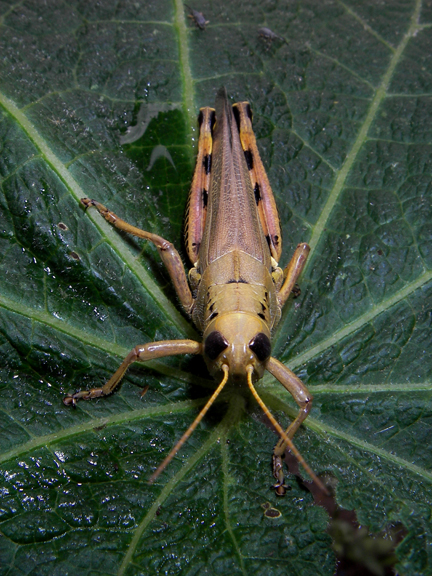 October 3, 2006 – Photo © 2006 by John Blair. Fall is grasshopper time and this one found solace on the leaf of a hollyhock plant in the Valley Watch Garden. It almost appears to be posing for the camera. For more Valley Watch Garden photos click the link below.
October 3, 2006 – Photo © 2006 by John Blair. Fall is grasshopper time and this one found solace on the leaf of a hollyhock plant in the Valley Watch Garden. It almost appears to be posing for the camera. For more Valley Watch Garden photos click the link below.
Go to Garden Photo Album
Seasonal Confusion!
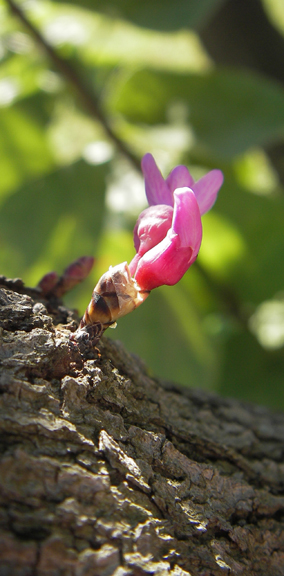 September 27, 2006, Photo © 2006 John Blair. This Red Bud bloom is either six months early or six months late for the typically spring blooming tree. While this sort of thing does happen in nature, “seasonal confusion” will occur more often as the impact of global warming and climate change takes full force.
September 27, 2006, Photo © 2006 John Blair. This Red Bud bloom is either six months early or six months late for the typically spring blooming tree. While this sort of thing does happen in nature, “seasonal confusion” will occur more often as the impact of global warming and climate change takes full force.
Climate change has become a fact of life. Heavy rains in the fall, drought in the spring, warmer than normal winters and who knows what will happen in the summer are patterns that will change our lives.
Just recently, James Hansen, the noted NASA scientist told reporters that we had a window of no more than ten years to correct the problem or face dire consequences of rising sea levels and extreme weather.
This region has experienced flooding in periods when there is usually little rain and tornadoes in the late fall and winter months.
But, currently, Valley Watch is fighting a number of coal fired power plants in the region even though coal burning is responsible for enormous quantities of Carbon Dioxide, the primary “greenhouse gas” pollutant.
Three Ducks on a Dazzling Day
 October 5, 2006-Photo © 2006 John Blair. Three white ducks stop for a rest at the Garvin Park Lake on their way south. The lake is a migration heaven for several species of ducks and hundreds of Canada geese. At this time, the City is building a concrete path around the lake for people to enjoy all aspects of the lake from every angle.
October 5, 2006-Photo © 2006 John Blair. Three white ducks stop for a rest at the Garvin Park Lake on their way south. The lake is a migration heaven for several species of ducks and hundreds of Canada geese. At this time, the City is building a concrete path around the lake for people to enjoy all aspects of the lake from every angle.
More Views from the Valley Watch Garden
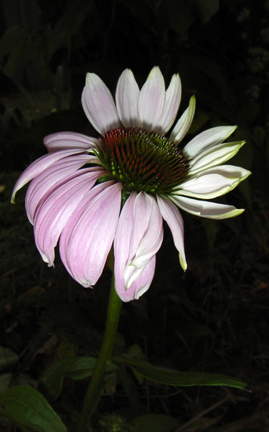
 October 20, 2006 – Cone flowers, or echinacea pretty much disappeared from the garden in August as heat and lack of sufficient water dried them up. But lots of recent rain and cooler temps have rejuvenated the plants which produce herbal supplements used around the world. Notice that this bloom has upward pointing petals and downward pointing petals which shows the plant’s confusion about the weather.
October 20, 2006 – Cone flowers, or echinacea pretty much disappeared from the garden in August as heat and lack of sufficient water dried them up. But lots of recent rain and cooler temps have rejuvenated the plants which produce herbal supplements used around the world. Notice that this bloom has upward pointing petals and downward pointing petals which shows the plant’s confusion about the weather.
Other garden varieties, including cosmos, zinnia and marigolds continue to thrive but next week’s anticipated cold front with temperatures in the lower 30s may cause an end to the garden.
But hey, it is the last week in October.
Conservation Organizations, Hunters and Anglers strive to develop habitat that is often destroyed by coal mining
 October 18, 2006 – Yesterday we ran a picture of a raccoon peering out of an Evansville sewer while we bemoaned the fact that habitat was disappearing at an alarming rate over the last few decades. Today’s Photo © 2006 John Blair shows five ducks swimming in the Garvin Park Lake one recent fall day.
October 18, 2006 – Yesterday we ran a picture of a raccoon peering out of an Evansville sewer while we bemoaned the fact that habitat was disappearing at an alarming rate over the last few decades. Today’s Photo © 2006 John Blair shows five ducks swimming in the Garvin Park Lake one recent fall day.
Habitat for wildlife is an ever changing dynamic. As urban sprawl spreads and many animals are forced into odd situations, conservation organizations like Ducks Unlimited, Quail Unlimited, Izaak Walton League and others work tirelessly to improve and create new habitat for wildlife.
Just last week, a columnist for the Evansville Courier praised the coal industry, claiming their reclamation programs “could create new habitat, ponds, lakes, croplands and marshes.”
Unfortunately, these new uses are not created, they are simply the result of the devastating ecological destruction that comes from stripping away the natural “creation” that existed on the land prior to being pillaged for our nation’s desire to waste energy.
Yes, there sometimes are beneficial uses for scarred land denuded of forests and natural ecology and sportsmen do often have access to new terrain for fishing and hunting as a result of coal mining.
But, what remains is something less than natural and often devoid of the total ecology that existed before mining took place.
But, large numbers of sportsmen, organized as groups or acting as individuals have secured land to create protected habitat for nature in areas that are not former strip mines, too. And, they are to be praised and thanked for their efforts.
Today, thanks to their efforts, there are large numbers of waterfowl, especially that simply did not exist twenty five years ago. Back then, it was rare to see a flock of Canada Geese going anywhere. Now, they are considered a nuisance around some homeowner’s lakes.
But, we need to remember that ecology is more than simply providing habitat for game that sportsmen crave, It also involves crawling and flying insects, song birds, raptors, reptiles and a wide assortment of plant life.
In reconstituted, reconstructed, “reclaimed” mining land, these species are often no longer seen.
Shrinking habitat forces raccoons to live in sewers
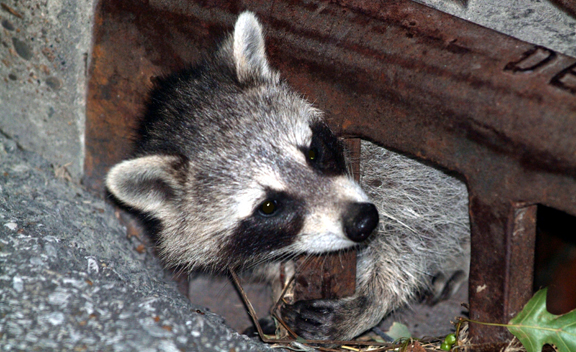 October 17, 2006-Photo and Text by John Blair, valleywatch.net editor. As urban sprawl sprawls, habitat for nature’s creatures shrinks.
October 17, 2006-Photo and Text by John Blair, valleywatch.net editor. As urban sprawl sprawls, habitat for nature’s creatures shrinks.
In the 1960’s it was rare to see a raccoon or an opossum in the urban environment but the advent of dumpsters brimming with trashed food has brought a significant change to the urban ecosystem.
Now, all sorts of critters have no where to live except where they can find food inside cities where they share space with rats and mice that used to have sewers and other urban habitat to themselves.
Among the creatures that were only rarely seen in cities just decades ago that regularly appear now are deer, raccoons, opossums, foxes, coyotes and myriad birds.
This little fellow was part of a raccoon “family” that lived in the sewer near the Valley Watch office during the day and came out in the evening to search for food in waste cans in the neighborhood.
Mystery bugs perhaps ladies in waiting
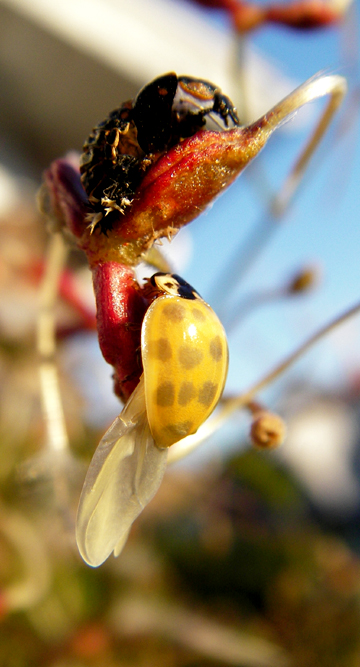 November 9, 2006 – Photo © 2006 John Blair. As temperatures reached into the seventies today, a search of the clematis plants in the Garden yielded kind of surprising results. As we reported earlier, the clematis plants had lots of funny looking bugs on their leaves, like the one on the top of this photo.
November 9, 2006 – Photo © 2006 John Blair. As temperatures reached into the seventies today, a search of the clematis plants in the Garden yielded kind of surprising results. As we reported earlier, the clematis plants had lots of funny looking bugs on their leaves, like the one on the top of this photo.
We can only speculate if the winged lady(bug) in waiting (the lower bug) is just another phase of the ladybug’s life.
Other insects were also seen in the garden today. A few bees, a wasp, and lots of mosquitoes were seen scurrying about in a frenzied preparation for winter.
For more pictures from nature check out the page below.
06 Nature Photos
Just hanging on-waiting for Winter
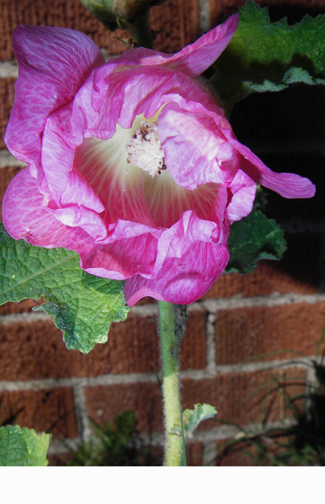 October 24, 2006 – Photo © 2006 John Blair. Its kind of late but this bloom appeared this week as the cold set in. It failed to completely open up but was saturated with color nevertheless. Hollyhocks are a hardy plant and will stay green most of the winter but they bloom mainly in the late spring and summer.
October 24, 2006 – Photo © 2006 John Blair. Its kind of late but this bloom appeared this week as the cold set in. It failed to completely open up but was saturated with color nevertheless. Hollyhocks are a hardy plant and will stay green most of the winter but they bloom mainly in the late spring and summer.
Hard Freeze reeks havoc on the Valley Watch Garden
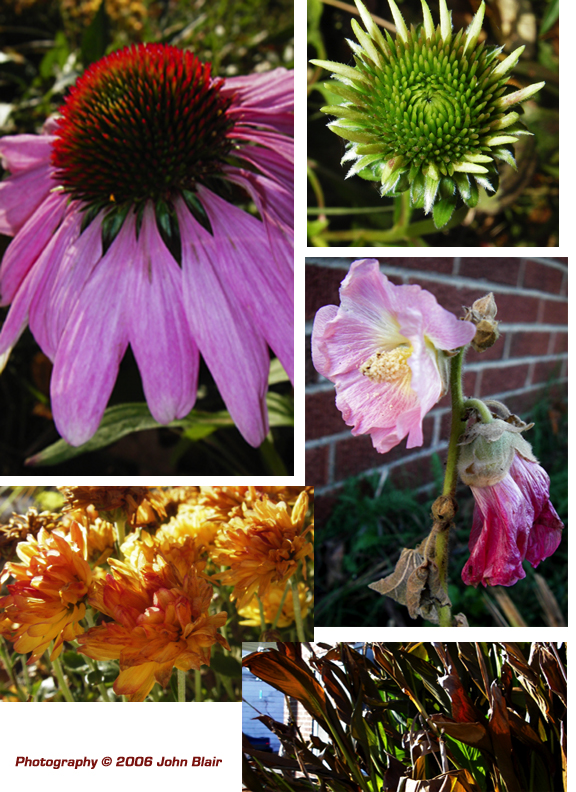 November 2, 2006 – Last night’s hard freeze changed the garden, but it did not destroy all the new life. Pictures shot today show the results of the freeze. But there is still life hanging on as evidenced by the new cone flower bloom pictured in the upper right. For more pictures from the Garden, click on the link below.
November 2, 2006 – Last night’s hard freeze changed the garden, but it did not destroy all the new life. Pictures shot today show the results of the freeze. But there is still life hanging on as evidenced by the new cone flower bloom pictured in the upper right. For more pictures from the Garden, click on the link below.
Go to 06 Nature Photo Album
Some leaf color keeps hanging on
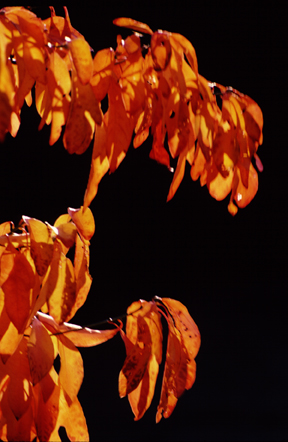 November 8, 2006 – Dogwood trees provide beautiful blooms in the Spring and in the fall they can show some really brilliant color as shown in this picture © 2006 John Blair
November 8, 2006 – Dogwood trees provide beautiful blooms in the Spring and in the fall they can show some really brilliant color as shown in this picture © 2006 John Blair
New insects move in after the freeze
This ladybug is perfectly at home on a decaying hollyhock plant. This hardy insect seems pretty active considering the falling temps we have experienced this week. Photo© 2006 John Blair
Sunny days punctuate coming holiday
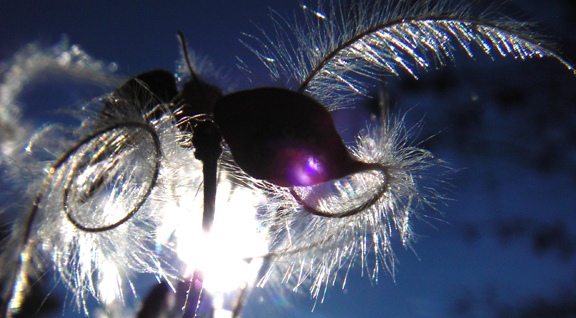 November 22, 2006 – Photo © 2006 John Blair. It almost doesn’t matter that temperatures are cool when the sun shines. As Thanksgiving arrives the continuing beauty of nature seems never to cease.
November 22, 2006 – Photo © 2006 John Blair. It almost doesn’t matter that temperatures are cool when the sun shines. As Thanksgiving arrives the continuing beauty of nature seems never to cease.
These are clematis seeds.
Bees still active but sluggish
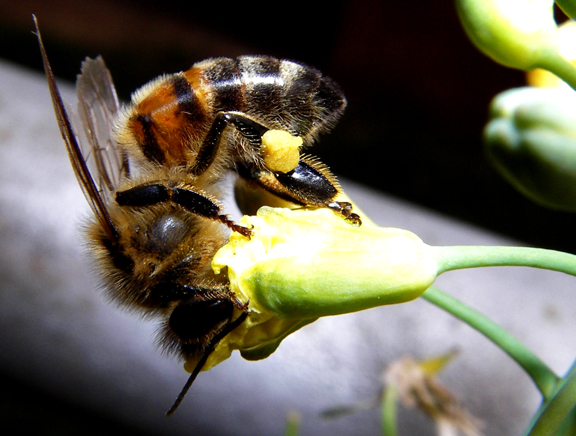 November 17, 2006 – Photo © 2006 John Blair. Bees are still gathering the little pollen that may be left as winter approaches. Bees have proven a fascination in the Valley Watch Garden this year. I would guess that I have photographed as many as 15 different species since they first appeared in March. This one sure looks healthy, feeding on broccoli flowers.
November 17, 2006 – Photo © 2006 John Blair. Bees are still gathering the little pollen that may be left as winter approaches. Bees have proven a fascination in the Valley Watch Garden this year. I would guess that I have photographed as many as 15 different species since they first appeared in March. This one sure looks healthy, feeding on broccoli flowers.
Tis the Season to be Holly
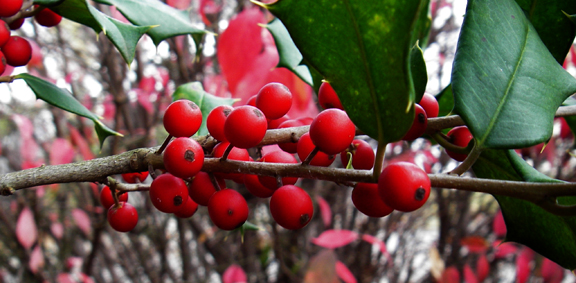 November 16, 2006 – Photo © 2006 John Blair. Almost nothing outdoors heralds the coming Christmas season like brilliant red holly berries contrasting with the bright green leaves of holly trees and bushes around the tri-state.
November 16, 2006 – Photo © 2006 John Blair. Almost nothing outdoors heralds the coming Christmas season like brilliant red holly berries contrasting with the bright green leaves of holly trees and bushes around the tri-state.
For more pictures of nature, please click the link below for the 2006 Valley Watch Nature Photo Album.
Go to Nature Photo Album
New life continues to emerge from the decay of autumn
Seasonal confusion reigns
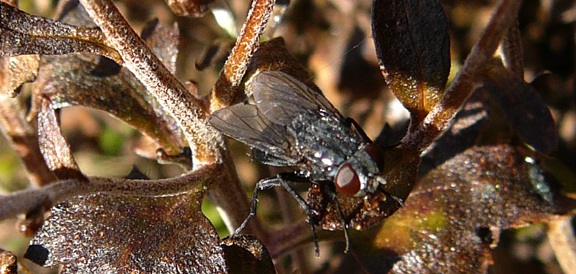 December 13, 2006 – Photo © 2006 John Blair. Like me, this fly is confused about the weather. Temperatures approaching 70 in the middle of December is just not right.
December 13, 2006 – Photo © 2006 John Blair. Like me, this fly is confused about the weather. Temperatures approaching 70 in the middle of December is just not right.
Just last week, temperatures were more normal, bottoming in the single digits with daily highs in the 40s. Now, however, we are in a warm front that will last for several days. More flies will think it is time to go hunting and maybe they will have a reason.
Dandelions are blooming again and even the crocus are already starting to get green.
It is hard not to like the balmy days but we should really be concerned about the causes of this phenomena. It sure seems that climate change is happening and it is happening now. While some areas will seem to benefit from warmer winter temps, the overall prospects presented by global warming may exact a hard price on people world wide.
Just love those coneflowers!
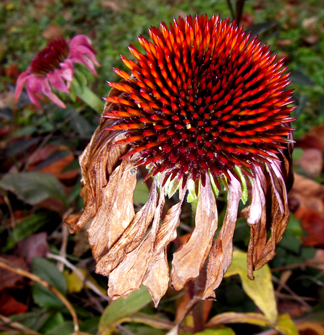 November 30, 2006 – Photo © 2006 John Blair. Snow may be on the way and the nights remain cold but the coneflowers just keep hanging on. Coneflowers or Echinacea are used internationally as an herbal supplement for improving immune systems of humans.
November 30, 2006 – Photo © 2006 John Blair. Snow may be on the way and the nights remain cold but the coneflowers just keep hanging on. Coneflowers or Echinacea are used internationally as an herbal supplement for improving immune systems of humans.
For me they are like an anti-depressant since they keep their color well into the fall and even when they dry up they continue to brighten my day with color. For more photography to brighten your day click the link below.
Nature Photo Album
Garvin’s ducks seem happy with freeze
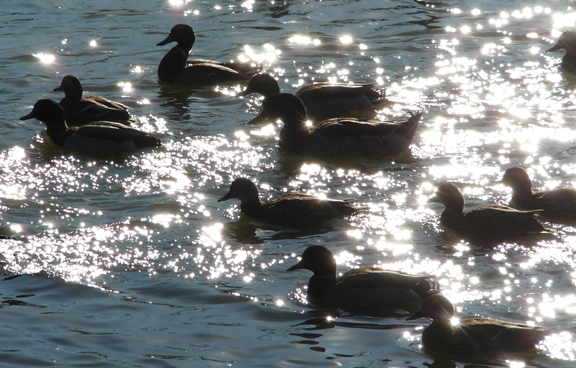 December 8, 2006 – Garvin Park’s ducks seem to take the cold weather in stride as they swim near the fountain in the Park’s lake. Falling temperatures have resulted in a crust of ice on much of the lake the last few days. Photo © 2006 John Blair
December 8, 2006 – Garvin Park’s ducks seem to take the cold weather in stride as they swim near the fountain in the Park’s lake. Falling temperatures have resulted in a crust of ice on much of the lake the last few days. Photo © 2006 John Blair
Once rare sight, Canada Geese are nearly a nuisance
 December 24, 2006 – Photo © John Blair. Fifty years ago, it was a rare sight when a flock of geese would fly overhead in the midwest, migrating to warmer climes in the winter and cooler locales in the summer. Now, however, they are seemingly everywhere a lake exist, thanks in large part to the efforts of hunters, who have used their conservation dollars to develop more and better habitat for waterfowl.
December 24, 2006 – Photo © John Blair. Fifty years ago, it was a rare sight when a flock of geese would fly overhead in the midwest, migrating to warmer climes in the winter and cooler locales in the summer. Now, however, they are seemingly everywhere a lake exist, thanks in large part to the efforts of hunters, who have used their conservation dollars to develop more and better habitat for waterfowl.
Nearly every morning, flocks of Canada Geese are heard as they make their landing approach at the Garvin Park Lake. Their distinctive “honk” is a reminder of just how prolific the geese have become overt the last twenty years.
What used to be a rare sight is now common as geese, ducks and other assorted water tenders have found increasing habitat in both urban and rural environments.
Much of that habitat development has been financed through the issuance of hunting and fishing licenses as well as through the efforts of NGOs like Ducks Unlimited.
Great Blue Herons dominate lower Ohio Valley
 December 17, 2006 – Photo © 2006 John Blair. Once rare birds have made a comeback and in a very big way.
December 17, 2006 – Photo © 2006 John Blair. Once rare birds have made a comeback and in a very big way.
Great Blue Herons are magnificent birds. They are great fishers and they dominate the skies near water in SW Indiana and Western Kentucky.
In the early 1980s, a friend drove me to a pond about twenty miles from Evansville to show me a couple of Blue Herons. They were a rare sight in those days.
But the Clean Water Act was passed in 1970 and a wider variety of fish soon were found in the Ohio River and its tributaries. Soon to follow were an increasing number of these great blue birds.
Now, Great Blue Herons can be found all along the River’s route, merrily fishing and giving the horizon a beautiful look as they gracefully stretch their long wings in flight.
This picture was shot at Kentucky’s Audubon State Park in Henderson, KY.
Tulips in December and it is not even winter yet
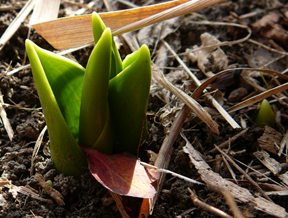 December 17, 2006 – Any doubts that we are experiencing global warming should fade as tulips are already emerging from soil warmed by high December temperatures and lots of rain.
December 17, 2006 – Any doubts that we are experiencing global warming should fade as tulips are already emerging from soil warmed by high December temperatures and lots of rain.
Winter Solstice is still a week away but that celestial extravaganza has not stopped tulips in the Valley Watch garden from emerging from the warm soil they are planted in.
This is the sort of “seasonal confusion” that has been evident of late due to the fact that 2006 is now on track to become one of history’s warmest years.
Lots of insects have also been spotted during this warm spell but they come and go. Unfortunately for the tulips, they will probably fail to provide their usual spring time glory since it is almost certain they will die off once it does once again freeze.


